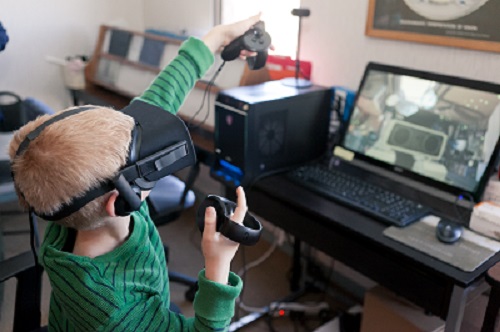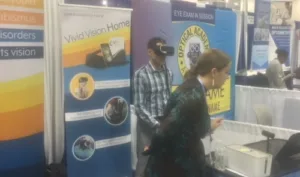Virtual Reality is making inroads in many areas these days, but none are as interesting as in the field of vision health. That’s because many people incorrectly suppose that healthy vision and VR are incompatible realities: we often hear that VR makes people sick, dizzy or uncomfortable.

VR at Optometry’s Meeting in Denver
This summer I attended the national convention of optometrists and vision health practitioners, called Optometry’s Meeting, hosted in Denver. It was a surreal experience, for sure, because it overlapped with a large ink (tattoo) conference in an adjacent hall. Geeks and freaks, side by side. It was a scene to behold. But I digress. Let’s return to the vision health mantra.
VR and Vision Therapy: a nice combination
One of the advanced technologies on display in the Optometry Meeting’s festive exhibit hall used virtual reality: virtual reality used in both Dx (diagnosis) and Tx (treatment) of vision disorders. The main player in this arena was Vivid Vision, a company operating out of the San Francisco Bay area. I was already familiar with their product, having previously penned two articles: “A Nexus Story: Vision, Learning, and Displays” and “The Screen Time Debate: Displays Fight Back” (subscription required). Both articles featured a six-year old boy, Tyler, who was undergoing vision therapy with the assistance of modern display technologies. (And, yes, Tyler makes another appearance in this article, so you can see what we are speaking about, although he is pictured below using a competing product from Optics Trainer VR.)
Tyler in VR gear at the clinic
Vivid Vision actually features three products. The first is a sports-focused trainer called Sports Vision. Their other two vision health products are called Vivid Vision and Vivid Vision Home. These products currently work with Vive, Rift, and GearVR headgear, with Daydream VR in the works. Here’s an overview of these tools:
Sports Vision
Sports Vision is a VR visual training system designed specifically for athletes. It offers tools to improve an array of sports-related visual challenges, including object tracking, depth perception, reaction time, hand/eye coordination, perception rates, peripheral vision quadrant loading, central lock, head lock and an amblyopic mode trainer.
Vivid Vision
Designed by doctors and researchers, the Vivid Vision VR therapy system was created for doctors’ offices and vision diagnostic centers. It’s a software and hardware bundle for treating amblyopia (lazy eye), strabismus (eyes that look in different directions), and vergence disorders (inability to see 3D or struggling with reading, as is the case with the six-year old featured in my pictures and video). Specifically, Vivid Vision includes tests for eye dominance, angles, Worth’s Four Dot (binocular), suppression, contrast sensitivity, and depth, which is the all-important stereo-acuity that most of us take for granted.
 A typical VR station in a vision clinic: it doesn’t take up much space, but needs space for the patient to move and gesture. Featured : Dr Jennifer Simonson, patient and Vivid Vision system.
A typical VR station in a vision clinic: it doesn’t take up much space, but needs space for the patient to move and gesture. Featured : Dr Jennifer Simonson, patient and Vivid Vision system.
The VIVID VISION system comes with a suite of VR-based games and activities designed to assess and treat the above vision disorders, accompanied by Leap Motion controllers to enable gesture control. Here’s an actual live diagnosis session showing how VR is used by a doctor to diagnose visual problems with a child:
Beyond the valuable diagnosis function shown in the above video, the Vivid Vision solution, in the words of the designer, is valuable for increasing “compliance with home-based therapy activities, follow-up and maintenance therapy, and continuity of care.” It looks like, without the motivating appeal of VR in the mix, it’s often difficult to get patients to continue needed therapies and eye exercises on their own.
Vivid Vision Home
Vivid Vision for home allows the vision therapy exercises to leave the doctor’s clinic and travel home with the patient. The home version can assess and track changes and improvements in vision from home, but must be prescribed by an eye doctor: Parents or patients cannot purchase this product on their own. In support of cost-sensitive home environments, this solution not only operates with the higher-end headgear, it also operates with smaller mobile devices such as Samsung or Google phones.
 A child using VIvid Vision VR for therapy. I’ll bet this is fun.
A child using VIvid Vision VR for therapy. I’ll bet this is fun.
Returning to the theme of VR making users sick, dizzy, or uncomfortable, I never tire of reminding people that VR is not the etiology (cause) of these problems, but it can certainly be the stimulus that kicks off our discomfort. That’s a signal to see your eye doctor. Enter VR as a Dx (diagnosis) and Tx (treatment) solution. It’s remarkably effective. –Len Scrogan

